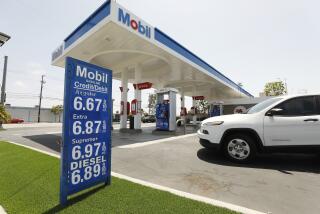Dipping Into the Strategic Petroleum Reserve
- Share via
Using deep underground salt domes along the Gulf Coast, an energy-shocked Uncle Sam began to squirrel away millions of barrels of crude oil in the 1970s as “doomsday insurance” against a cutoff of oil imports.
But today, Democrats and Republicans alike have begun to treat the precious cache of crude--known as the Strategic Petroleum Reserve--as a sort of fiscal cookie jar.
With little public notice, Congress and the Clinton administration have already authorized two sales of oil from the reserve to attack the federal budget deficit, and they are plotting to sell an additional $1.5 billion worth of the oil as part of a bid to balance the budget by 2002.
Just as the American public finds itself whipsawed once again by turmoil in petroleum markets and a sudden run-up in gasoline prices, one of the nation’s bulwarks against a serious disruption of world oil supplies is being squandered, critics charge.
Sales of strategic oil are a “costly and misguided precedent,” petroleum expert John Lichtblau told Congress on Wednesday. “The question of selling Strategic Petroleum Reserve oil can now be expected to come up at every annual budget debate, and the politics will usually be on the side of further reductions.”
The latest furor over gas prices has thrust the reserve into the public eye for the first time in years, unmasking a host of political and technical shortcomings that have been festering unnoticed. Among them:
* The U.S. has fallen far short of its original goal of a 1-billion-barrel reserve. In 1995, the reserve topped out at about 592 million barrels. Since then, it has dropped to 587 million barrels and is headed down to 575 million.
* Congress and the White House have decided to reduce the size of the reserve without having formally studied the matter.
* The government has proved to be a poor investor, selling oil for $19 a barrel that it purchased for an average of $27 a barrel. Total return so far: a negative $4.7 billion.
* Poor engineering in the 1970s is coming back to haunt the Energy Department. One of the salt mines used to store the oil is fracturing, forcing the department to pump the oil out, at a cost of about $100 million.
Its problems notwithstanding, the Strategic Petroleum Reserve remains an important defense against future oil market disruptions and selling it off to raise money is unjustified, according to Kyle Simpson, associate deputy secretary of energy.
At a hearing of the House Commerce Committee’s Energy and Power Subcommittee on Wednesday, Simpson said the Energy Department had tried unsuccessfully to persuade the White House and Office of Management and Budget not to sell off portions of the reserve.
The most recent sale, for a total of up to 15 million barrels, was approved by Congress and signed into law by President Clinton in late April with little if any publicity.
The sale was engineered by congressional and White House officials as part of a package to finance about $4 billion in additional federal spending that Clinton wanted, including roughly $1 billion in added appropriations for education.
The deal was struck just as political outrage over the spiraling of gasoline prices was building and Clinton’s presumptive opponent for the presidency, Sen. Bob Dole (R-Kans.), was demanding a repeal of a 4.3-cent-a-gallon federal gasoline tax hike that Clinton pushed through in 1993.
So shortly after signing the appropriations bill, Clinton announced that he was “ordering” the sale of the petroleum in an effort to increase the supply so as to combat the recent spiral upward of oil prices--even though the legislation compelled him to do so in any case.
An additional $1.5-billion sale of crude was proposed by Clinton in his fiscal 1997 budget, part of a plan to balance the budget by 2002.
In fact, by some measures, the oil reserve is already too small, according to industry experts.
“At a minimum, we should not touch it,” Lichtblau told Congress. “If 1 billion barrels was right 15 years ago, why should less than half that be too much now?”
Indeed, U.S. dependence on oil imports is as high today as it was in the mid-1970s, and the dependence is projected to continue growing in the next decade, suggesting that a larger reserve would be warranted, experts say.
But a senior Clinton administration official, speaking on background, said Wednesday that a number of factors justify a smaller reserve and that the decision to support the oil sales was made after an “internal administration dialogue.”
Although the White House wrote no formal reports on the subject, the administration official said that the Organization of Petroleum Exporting Countries is weaker today than in the past and that U.S. influence in the Middle East is stronger.
“There was an analytic argument that said we could do with less,” he said.
But some members of Congress see the selling policy as economic folly.
“Every time we sell oil from the reserve to balance the budget, taxpayers lose money and, more importantly, energy security,” said Rep. Dan Schaefer (R-Colo.), chairman of the energy and power subcommittee.
The genesis of the notion to sell reserve oil began with a sale two years ago to finance the relocation of the Weeks Island reserve site, which was fracturing and at risk of leaking oil into the local marine environment.
Since Congress was in no mood to appropriate the $100 million for the problem, it ordered the Energy Department sell reserve oil to finance the job.
That decision quietly set up a precedent, demonstrating to politicians that the reserve was a source of money that could be tapped with little controversy.
* TOPPING OFF
Gasoline prices begin to fall. A1
More to Read
Sign up for Essential California
The most important California stories and recommendations in your inbox every morning.
You may occasionally receive promotional content from the Los Angeles Times.














